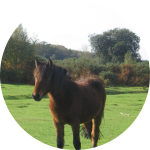|
Depending on breed, management and environment, the domestic
horse today has a life expectancy of 25 to 30 years. It is
uncommon, but a few horses live into their 40s, and, occasionally,
beyond. The oldest verifiable record was "Old Billy," a horse
that lived in the 19th century to the age of 62. The size
of horses varies by breed, but can also be influenced by nutrition.
The general rule for cutoff in height between what is considered
a horse and a pony at maturity is 14.2 hands(h or hh) (147
cm, 58 inches) as measured at the withers. An animal 14.2h
or over is usually considered a horse and one less than 14.2h
is a pony.
However, there are exceptions to the general rule. Some smaller
horse breeds who typically produce individual horses both
under and over 14.2h are considered "horses" regardless of
height. Likewise, some pony breeds, such as the Pony of the
Americas or the Welsh cob, share some features of horses and
individual animals may occasionally mature at over 14.2h,
but are still considered ponies. The difference between a
horse and pony is not simply a height difference, but also
a difference in phenotype or appearance. There are noticeable
differences in conformation and temperament. Ponies often
exhibit thicker manes, tails and overall coat. They also have
proportionally shorter legs, wider barrels, heavy bone, thick
necks, and short heads with broad foreheads.
Light horses such as Arabians, Morgans, Quarter Horses, Paints
and Thoroughbreds usually range in height from 14.0 (142 cm)
to 16.0 hands (163 cm) and can weigh from 386 kg (850 lbs)
to about 680 kg (1500 lbs). Heavy or draft horses such as
the Clydesdale, Belgian, Percheron, and Shire are usually
at least 16.0 (163 cm) to 18.0 hands (183 cm) high and can
weigh from about 682 kg (1500 lb) up to about 900 kg (2000
lb). Ponies are less than 14.2h, but can be much smaller,
down to the Shetland pony at around 10 hands, and the Falabella
which can be the size of a medium-sized dog. The miniature
horse is as small as or smaller than either of the aforementioned
ponies but are classified as very small horses rather than
ponies despite their size. The largest horse in history was
a Shire horse named Sampson, later renamed Mammoth, foaled
in 1846 in Bedfordshire, England. He stood 21.2 hands high
(i.e. 7 ft 2 in or 2.20 m ), and his peak weight was estimated
at over 3,300 lb (approx 1.5 tonnes). The current record holder
for the world's smallest horse is Thumbelina, a fully mature
miniature horse affected by dwarfism. She is 17 inches tall
and weighs 60 pounds.
Horse breeding
Pregnancy lasts for approximately 335-340 days and usually
results in one foal (male: colt, female: filly). Twins are
rare. Colts are usually carried 2-7 days longer than fillies.
Females 4 years and over are called mares and males are stallions.
A castrated male is a gelding. Horses, particularly colts,
may sometimes be physically capable of reproduction at approximately
18 months but in practice are rarely allowed to breed until
a minimum age of 3 years, especially females. Horses four
years old are considered mature, though the skeleton usually
finishes developing at the age of six, and the precise time
of completion of development also depends on the horse's size
(therefore a connection to breed exists), gender, and the
quality of care provided by its owner.
Also, if the horse is larger, its bones are larger; therefore,
not only do the bones take longer to actually form bone tissue
(bones are made of cartilage in earlier stages of bone formation),
but the epiphyseal plates (plates that fuse a bone into one
piece by connecting the bone shaft to the bone ends) are also
larger and take longer to convert from cartilage to bone as
well. These plates convert after the other parts of the bones
do but are crucial to development.
Depending on maturity, breed and the tasks expected, young
horses are usually put under saddle and trained to be ridden
between the ages of two and four. Although Thoroughbred and
American Quarter Horse race horses are put on the track at
as young as two years old in some countries (notably the United
States), horses specifically bred for sports such as show
jumping and dressage are generally not entered into top-level
competition until a minimum age of four years old, because
their bones and muscles are not solidly developed, nor is
their advanced training complete.
Horses are adapted to grazing, so their teeth continue to
grow throughout life. There are 12 teeth (six upper and six
lower), the incisors, adapted to biting off the grass or other
vegetation, at the front of the mouth, and 24 teeth, the premolar
and molars, adapted for chewing, at the back of the mouth.
Stallions and geldings have four additional teeth just behind
the incisors, a type of canine teeth that are called "tushes."
Some horses, both male and female, will also develop one to
four very small vestigial teeth in front of the molars, known
as "wolf" teeth, which are generally removed because they
can interfere with the bit. There is an empty interdental
space between the incisors and the molars where the bit rests
directly on the bars (gums) of the horse's mouth when the
horse is bridled.
The incisors show a distinct wear and growth pattern as the
horse ages, as well as change in the angle at which the chewing
surfaces meet, and while the diet and veterinary care of the
horse can affect the rate of tooth wear, a very rough estimate
of the age of a horse can be made by looking at its teeth.
Author Resource:
Keith Londrie II is the Webmaster of http://horse.about-animals.info
A website that specializes in providing information on horses
that you can research on the internet at your own pace.
|


